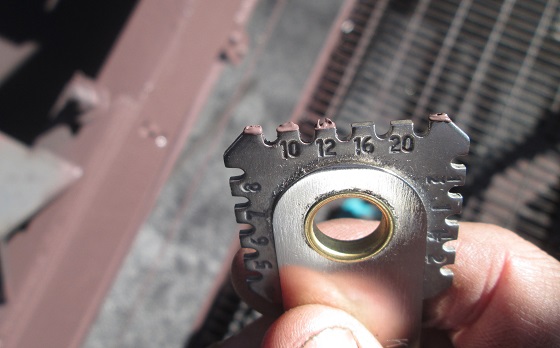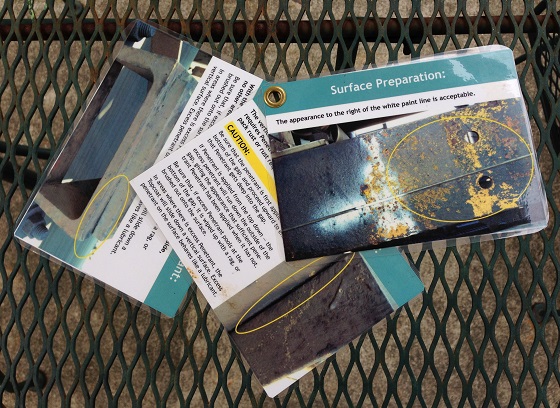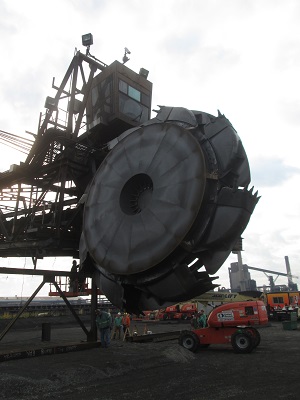Mark Twain has been attributed to the saying, “It ain’t what you don’t know that gets you into trouble. It’s what you know for sure that just ain’t so.” An experience with a lead-coated coal stacker exemplifies this notion.
I remember it as an overcast day during the spring of 2014. We were working for the largest steel company in the world at one of their facilities just over the Illinois border in Indiana. We were working on a wide variety of projects — all pertaining to corrosion mitigation — when we were asked to evaluate repainting a coal stacker.
At roughly 150' (45.7 m) long with a bucket wheel roughly 30' (9.1 m) round, our target was small, as coal stackers go. The wheel moves around a pivot point, scooping up coal, dumping it onto a conveyer belt, and moving it to the coke foundry for processing.
Shutting down the stacker, even for a day, is monumentally costly as dozens of trucks and front loaders must be brought in to continue to feed the coke processing unit around the clock. Shutting it down, as I recall, cost the client hundreds of thousands of dollars per day.
We were late to the game. Plans were already in motion, and a broad range of maintenance was being carried out, including replacement of gears, deflection plates, and dozens of other details beyond our scope. Work was slated to begin in a few weeks and the turnaround (TAR) was set to last for only 72 hours.
As we sat in a meeting room with a dozen or so hard-hatted, coal-dust-covered engineers, someone mentioned that lead abatement would take about 22 hours.
My ears perked up. “Can I hear more about lead abatement?” I queried. All heads turned.
I explained that many times, the lead is in the primer and we may want to take a closer look at the condition of the paint system to evaluate next steps.
The abatement contractor was there, and the rest of the team was not happy about my interjection. After all, they had a path forward and contracts had already been issued. But my contact leaned over and said we could discuss it later. It turns out that lead had been identified in the existing paint system, which was starting to peel, and that someone in their environmental division had determined that it needed to be removed.

History of Lead
As an old-timer, encountering lead-based paint (LBP) was not uncommon to me. Prior to 1978 (before it was banned), LBP was used everywhere and often. Lead adds remarkable characteristics to paint: It is cheap, opaque in even the smallest quantities, allows paint to dry faster, is durable, and moisture and chemically resistant. One can even store sulfuric acid in a lead bowl if so inclined.
At a trade show about 20 years ago, I ran into a gray-haired painter who nearly came to tears describing what it was like applying lead paint. “It was so smooth,” he lamented. “It was like painting warm butter on toast.”
But, of course, we now know that lead is toxic, and it can contribute to developmental delays, neurological changes, and other nefarious issues. In fact, some historians believe that the fall of the Roman Empire might be, in part, attributed to poisoning from all of the pure lead water pipes as well as from drinking lead as a curative or with wine. Lead, evidentially, imparts a sweet taste, which is one of the reasons it’s so dangerous in homes with young children.
So, that’s the bad news about lead.
The good news is that very often it was used as a paint primer, and, if applied properly and stayed well adhered, there was no reason to remove it. If in good standing, lead-based primers could stay forever, particularly at a 100-year-old coal field that would never be rezoned as a playground or shopping center.
Research and Testing
On this stacker, time was of the essence as our client had already contracted with the lead abatement contractor and work was scheduled to begin in only a few weeks. We had to move quickly.
First, we had to determine where the lead was. This was an easy fix. My team and I climbed up the stacker, did some scraping of paint, and used a lead tester from Home Depot to identify where the lead actually was. And just as we hoped for, it was exclusively located within the primer.
Second, we met with the in-house environmental team and an outside environmental engineering firm to determine, if any lead would be released if we water-blasted the stacker to remove the peeling topcoat. We tarped a roughly 100-foot by 100-foot (30.5 m x 30.5 m) area on the ground and water-blasted at different pounds per square inch (PSI) with documentation. This helped us to determine how aggressively we could blast without releasing any lead. All of the water was captured, as well as the topcoat paint chips.
There was more good news: No lead was detected in the water or paint chips that had fallen on the tarp. The LBP appeared to be well adhered. We went a step further and conducted a number of pull tests (per ASTM D4541), which quantitatively confirmed excellent adhesion.

Lastly, we had to find a paint that would adhere to the LBP primer and provide long-term performance. Before we were brought onboard, someone had specified a coating system designed for a bridge: a standard zinc-rich primer, epoxy mid coat, and a urethane topcoat.
It was determined, though, that this was a waste of time and money. There was no time available between coats for a 72-hour TAR. Further, we were no longer removing the primer, which meant that abrasive blasting was no longer required. As such, we needed something that was surface-tolerant, durable, easy to apply, and readily available on short notice.
It was no problem. We identified an exotic material out of Canada called a high-ratio, co-polymerized calcium sulfonate. It is a peculiar, single-component, single-coat material with no pot life and, so we were told, a near infinite recoat window. Further, it never gets hard. Unlike other traditional paint systems, this material stiffens up over time, but 20 years after application, you can still scrape into it with a key.
We had a technician fly in from Canada the following week and conducted a proof of concept, which determined:
1. What PSI to use when power washing;
2. What type of tip to use when power washing;
3. How far to “stand off” from the substrate when power washing; and
4. The best manner by which to apply the material.
Successful Outcome

Everything was working like clockwork, but no one had anticipated the ubiquity of the coal fines. Just as the word implies, coal fines are incredibly small pieces of coal dust that simply fly everywhere, even with the wispiest of winds. Shortly after paint application, the fines would start to cover the paint system.
After some study and research, we determined that the fines would not harm the system and, in fact, might provide additional protection of the soft film over time.
The painting contractor had never used the material so we created waterproof, laminated comparators, which the contractors could hang on their belts to match the photo to the substrate for water blasting (not too hard, not too soft). They also helped the applicators address details, such as nuts, bolts, and joints. We went as far as specifying a novel type of lighting system, too, so that the highly detailed work could continue through the night.
Overall, our involvement saved the client hundreds of thousands of dollars in LBP remediation, and we were able to paint nearly the entire stacker during the 72-hour TAR, rather than only 20 percent of it. Had they gone through with the lead abatement and tried to install the three-coat system, the results would have been very different. This project just goes to show that corrosion mitigation is not one size fits all. Sometimes, even now, lead paint is still the right solution.